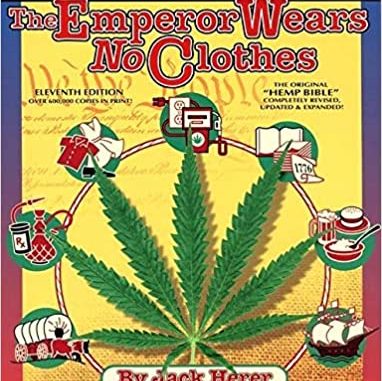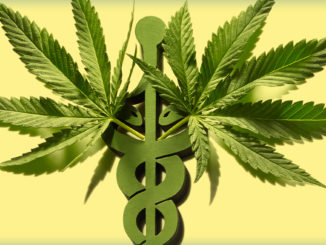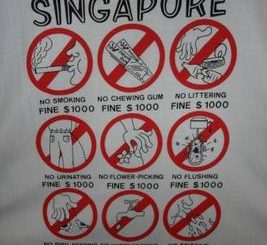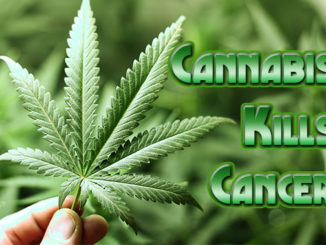
The Emperor Wears No Clothes is a timeless non-fictional book about the versatile plant Cannabis sativa that every marijuana proponent should be informed about. The author, Jack Herer, presents a historical, social, and economic view of hemp based on twelve years of research. Sixty consistent years of government deception and suppression of the truth, topics ignored by most media, are revealed in this enraging book about marijuana prohibition.
This book, whose title makes an analogy to the classic children’s tale The Emperor’s New Clothes, surprises, enlightens, shocks, angers, and initiates activism as it informs about one of nature’s most utilitarian plants. It covers general facts about Cannabis sativa, history of it’s use, the effects of smoking the plants flower buds, the many other uses for the plants other parts, the corruption of the U.S. government and of the wealthy and powerful corporations to whom Cannabis sativa is business competition, the “War on Drugs”, the ignorance of our constitutional rights, and suggestions on how we can protect them.
Hemp is a dioecious, woody, herbaceous annual. Each short growing season it reaches heights of twelve to twenty feet, and grows well in any climate or soil condition. Its roots penetrate deep (one foot per month), breaking up compacted and overworked soil, and combating soil erosion. Since it grows so quickly, it could be a year round crop, harvested twice a year, or it could be planted as a second crop, after harvest of a different one. Hemp is also resistant to UV radiation damage, a current threat to 30-50% of soya production. In fact, hemp actually flourishes in the presence of high UV radiation since it protects itself by creating more cannabiniods. This willing plant is able to provide many basic needs of humans anywhere on the planet: food, medicine, treeless shelter and paper, clothing and other textiles, and a renewable fuel alternative to those presently creating acid rain, global warming, and deforestation.
One acre of hemp provides the same amount of cellulose and fiber pulp, used to make paper products and pressed or particleboard, as four acres of trees, while producing four to seven times less pollution. More than anything else, the U.S. imports textiles. Hemp is softer, warmer, stronger and more absorbent than cotton, and it doesn’t require the agricultural chemicals that cotton does. Loggers and truck drivers would still have jobs, reforestation could occur; and rivers could recover from wood and paper chemicals.
Nutrition wise, hemp seed is the highest in essential fatty acids and the lowest in saturated fats. It can be made into a tofu-like curd at a cheaper cost than can soya, sprouted to make milk and ice cream or for use in salad, ground and used like flour, or pressed into an oil, whose by-product is a high protein animal feed.
Hemp as fuel for industrial use, electricity, and transportation -each acre is capable of yielding 1,000 gallons of methanol; that’s ten tons per acre every four months. It’s an annually renewable fuel source, that can be grown for this purpose at the cost of only thirty dollars a ton, Hemp for biomass could be a trillion dollar a year industry, while also improving air quality, reducing our dependence on foreign oil, and bringing millions of jobs in energy production, distributing wealth to rural areas and away from the monopolies.
The hurds (pulp left over after fiber is removed) are 77% cellulose (that’s 50-100 times the cellulose found in sugarcane or corn stalks) that could be used to produce chemicals, biodegradable plastics, paint, dynamite, and fibers.
Around the same time as pottery making, people began weaving hemp; it’s the earliest known woven fabric (8,000-7,000 B.C.). Based on evidence using the Bushmen of Africa, Scientist-Philosopher Carl Sagan suggested that hemp may have been the first cultivated plant dating back to hunter-gatherer time. By 1,000 years B.C. hemp was believed to be our planets largest agricultural crop. Between the years of 1763 and 1767, during a cannabis shortage in America, you could be jailed for not growing it. Our forefathers George Washington and Benjamin Franklin grew it. It’s even been speculated by historians that the ‘War of 1812’ was about hemp! According to the 1850 U.S. Census they counted 8,327 hemp plantations, each over 2,000 acres large – this doesn’t count family patches or small farms. Until 1883 75-90% of all paper in the world was made of hemp fibers, and until 1937, 70-90% of all rope was hemp. For thousands of years almost all paints and varnishes were made of hempseed and linseed oils (in 1935 alone, in the U.S., 58,000 tons of hempseed were used for this purpose). In the early 1900’s the U.S. Department of Agriculture foresaw the huge potential that marijuana had to be the planets largest industry, claiming that once a machine was invented that could harvest, strip, and separate the fiber from the pulp that hemp would be the U.S.’s number one crop. In 1916, the U.S. government was advising and offering American farmers incentives to grow marijuana for plastic, paper, fiber, and energy needs. In 1917, GW Schlicten realized this mechanic vision the USDA had been waiting for; he called it a ‘decorticator’. Both Popular Mechanics and Mechanical Engineering magazines wrote articles foreseeing hemp as being the ”new billion dollar crop” (It’s estimated that today, in the U.S., the hemp industry could be raking in five hundred billion to one trillion dollars annually). In 1942 the U.S. Department of Agriculture even put out a war movie titled “Hemp For Victory”, urging farmers to grow it.
So what happened, you ask? Soon after the ‘decorticator’ was invented, DuPont invented petrochemical fibers and all too easily ‘convinced’ the U.S. Congress and Treasury that with his technology, they could replace hempseed oil with these synthetic petrochemicals. The U.S. Treasury dutifully drafted the Marijuana Tax Act. Stick with me as I attempt to untangle this tangled web of interconnected corruption they’ve woven-DuPont’s financial lending institution was Mellon Bank. President Hoover’s Secretary of Treasury was Mellon. Mellon then appointed a member of his extended family, Harry Anslinger, as head of the Federal Bureau of Narcotics and Dangerous Drugs (currently known as the DEA-Drug Enforcement Agency). DuPont, who had just patented a method of making plastic from oil and coal (enter the interests of oil companies), along with Hearst Paper Company, also feeling threatened by the invention of the ‘decorticator’, paid politicians to outlaw marijuana as a ‘narcotic’, and suppress hemp knowledge from schools, researchers, and scientists.
In the U.S., from the 1840’s through the 1890’s, Cannabis sativa was being used medicinally. In fact, during this time marijuana tinctures and extracts were the second and third most used medicines in America. At this point in history, for over 3,500 years, Cannabis sativa had been the most widely used plant medicinally all over the world. By 1883 every major city in the U.S. had legal hashish smoking bars. In 1930 the U.S. government did a study on the effects of smoking the herb on off-duty American servicemen in Panama. They came to the conclusion that marijuana smoking wasn’t a problem and recommended that no criminal penalties apply to its use. Seven years later the Assistant U.S. Attorney General announced that marijuana could be used long term without “social or emotional outbreaks” and that it was only habit forming on the same level as coffee or sugar. Based on the next seven years of study, in the La Guardia Marijuana Report, the mayor of New York City, Fiorello LaGuardia, the New York Academy of Medicine, and the doctors’ researching the report also concluded that marijuana did not cause any kind of violence, and that it also had positive effects on it’s smokers.
Marijuana has never acted as a ‘gateway drug’; in fact it’s been used in alcohol addiction treatment. In Costa Rica, where smoking is socially accepted, as opposed to on neighboring ‘cannabis-free’ islands, they don’t experience the alcoholic social problems of their island neighbors; and in Holland, where marijuana is available in coffee shops and bars, and smokers aren’t persecuted, the number of heroin addicts has declined by 33% since legalization. 1968-1975 Jamaican studies of people who had smoked high level THC marijuana for 6-30 years, in heavy quantities, showed no social consequences, like relation to crime and no psychological consequences, like impairment of motor skills or mental problems. What it did reveal was the plants positive effects as a work motivator, as a tool for concentration and meditation (by the way, marijuana has a historical use in many major religions worldwide), creating an all around sense of well-being, self-assertiveness, and a merry, conscious, and responsible attitude.
Since 1964, at least 60 of over 400 separate compounds that have been isolated from over 1,000 suspected compounds have been found to be therapeutic. In America today there are over 26 million daily marijuana smokers, and 40 million ‘occasional’ smokers. Some therapeutic uses of smoking: stops asthma attacks, reduces ocular pressure of those with Glaucoma, relieves nausea, stimulates appetites of chemotherapy patients and anorexics, lung expectorant, antispasmodic, reduces intensity of epileptic seizures, relieves symptoms of Muscular Dystrophy, relieves migraine headaches, lowers blood pressure, relaxes muscles, relieves stress, promotes a restful sleep, relieves dementia and depression, and invokes positive ‘vibrations’-all without the negative, and sometimes deadly side effects of pharmaceuticals. The plants antibiotic cannabidiolic acids can be applied in a topical form to treat gonorrhea, herpes, arthritis, rheumatism, and cystic fibrosis. Two universities in Madrid, Spain, involving studies on mice and rats stated that, Cannabis sativa’s active ingredient, THC, killed tumor cells in a type of cancer previously thought to be 100% fatal. Cannabiniods, the plants active compounds, when injected directly into cancerous brain tumors, were found to completely destroy the tumors, while leaving normal cells untouched. More recent studies show that THC even has its own unique receptor sites in the brain, to which, so far, no other compounds have been found to bind.
These were some reasons the pharmaceutical companies got worried. If marijuana were to be legalized, right away it would replace 10-20% of pharmaceutical drugs, taking billions of dollars a year away from the pharmaceutical companies, who have so far been unsuccessful at synthetically replicating the positive effects of marijuana. Roughly ½ of the funds contributed to government sponsored ‘against marijuana’ groups come from American pharmaceutical drug companies. The other ½, surprise, surprise, come from the legal tobacco and liquor companies (oil and paper companies are also contributors). In its 10,000-year-old history, zero deaths have been linked to marijuana, but each year alcohol is linked to 100,000 deaths and 70% of child rape, wife beating and murders. An even worse offender is tobacco, as addictive as heroin, which kills more people each year than AIDS, heroin, crack, cocaine, alcohol, car accidents, fire, and murder combined. Meanwhile, Tobacco receives more government subsidies than any other agricultural product in the U.S.. In 1976 Aslinger, head of the DEA, went on a warpath. He denounced the previously mentioned studies, the American Medical Association, and The New York Academy of Medicine and it’s doctors, and forbade all federal research on the therapeutic effects of marijuana, even to universities. However, a special exception was made for the pharmaceutical companies, who are not only the only ones allowed to research it, but they even are trusted to regulate themselves.
The American Medical Association spoke out against this law, testifying that what the government was saying about marijuana was “outright tabloid sensationalism” and that the prohibitive marijuana laws would deny the world medicine that had been being safely used for a plethora of symptoms for thousands of years. In 1988, even a DEA judge, after considering fifteen days of testimony and DEA reports, concluded that, “Marijuana is one of the safest therapeutically active substances known to man”. Still, a year later the director of the DEA ordered Cannabis to remain listed as a schedule one narcotic-one having no known medicinal use!
Prison building is currently the largest growth industry. Every state in America is expanding its prisons. Since the 1998 birth of the DEA’s “War on Drugs” 75% of those imprisoned (600,000 a year) are there for mere possession of marijuana for personal consumption (not dealing), and since this “war” began, this is what our drug enforcement tax money has been paying for.
In the authors analogy of his book to the well-known children’s book The Emperor’s New Clothes, Jack Herer likens the Emperor’s lies and manipulation to that of our U.S. government, compares the Emperor’s powerful guards to our FBI, CIA, DEA, etc. Like the Emperor, our government uses its power to buy the allegiance of other countries through bribery or intimidation (foreign aid, arms sales). And like in the children’s story, anyone daring to speak out is slandered, threatened by loss of job, property, or family. Herer likens the Government, using fear and a virtual police state, paid for by our own taxes, to tyrants and prohibitionists of the past who relied on brute force and intimidation. The Emperor Wears No Clothes (because exposed by the truth) author, Jack Herer, alerts us that “it’s a crime against our citizens Bill of Rights (written on hemp paper) to imprison innocents to wage a campaign of lies and omission of the facts with our taxes” such as that which has been carried out by our last four presidents (Bush, Clinton, Bush, Reagan), and that “they’re taking away more of our guaranteed constitutional rights than have been taken away for political actions, insurgencies, strikes, uprisings, and wars in the last 200 years combined. In 1999, Herer warned that a top priority of the government, the DEA, and the Republican Party is to pass a bill that automatically takes away 100% of your rights to privacy and freedom from an unwarranted search (A prophecy of the Patriot Act?).
What can we do to preserve our basic rights? Herer suggests working to get the issues on the ballots, so we can vote like we’re supposed to be able to do, educating others about hemp, and demanding the release of the POW’s of the “War on Drugs”.
Proudly WWW.PONIREVO.COM
by Elle Housman



